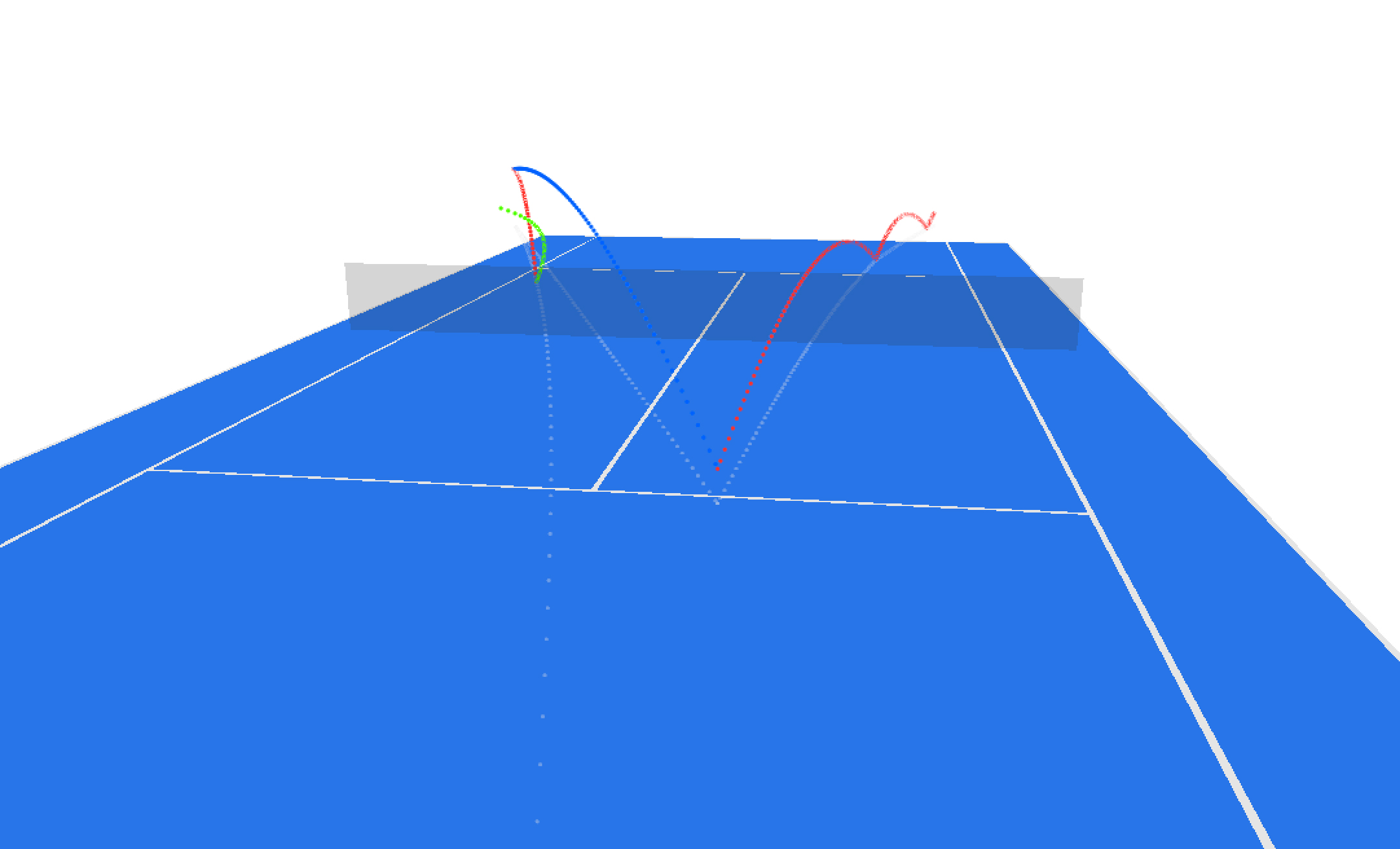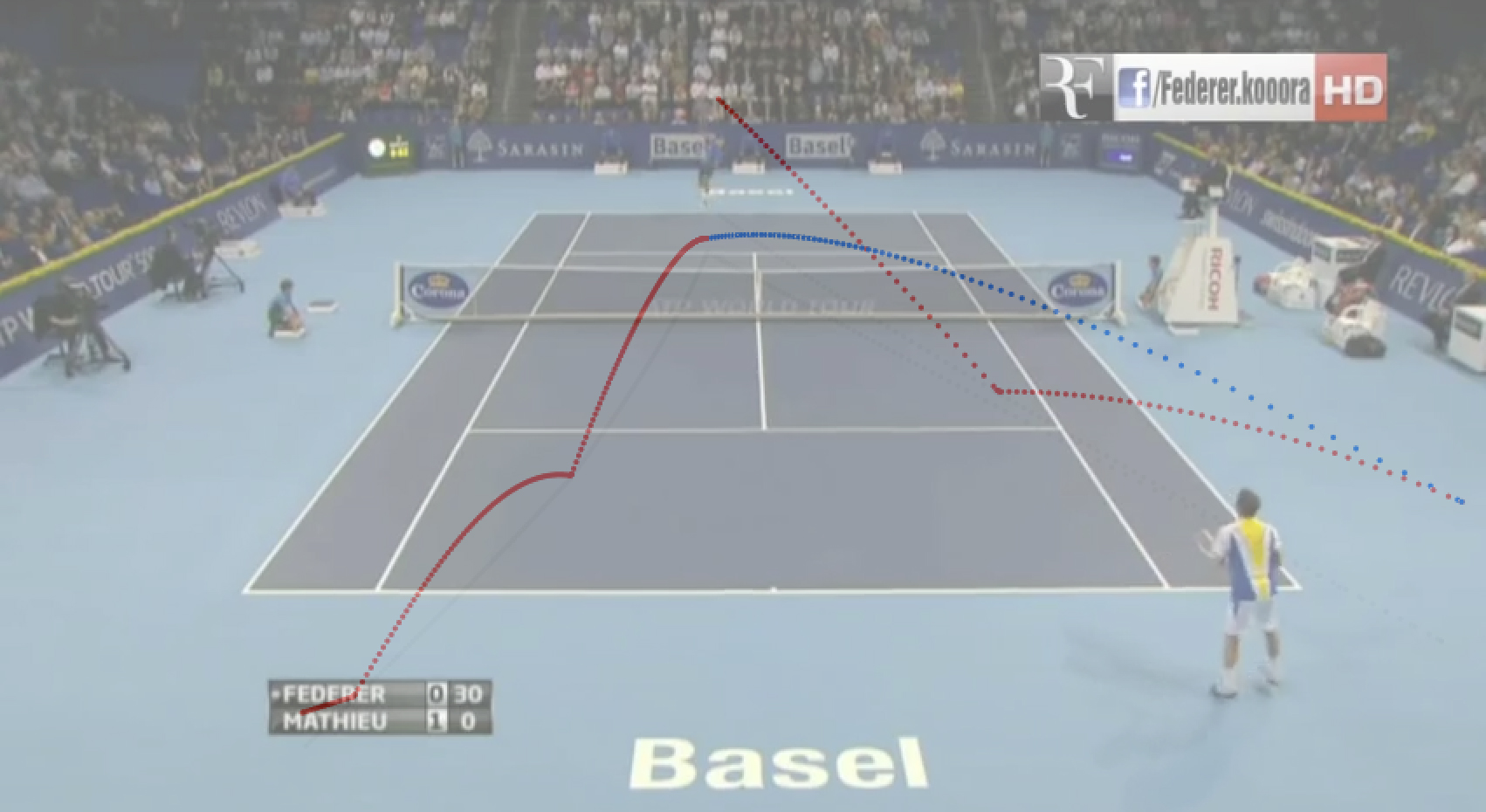Roger Federer claimed his 23rd ATP World Tour 1000 Masters title on the weekend by beating Gilles Simon 7-6(6), 7-6(2) in Shanghai. Whilst this wasn’t Federer’s most memorable match of his career, he was able to get the job done when it mattered most. However, the match that everyone is still talking about is his semi-final win over Novak Djokovic. For it was Federer that turned back the clock by putting on a masterclass of serve and volleying.
Last night I pulled down some Hawk-Eye data from a match Federer played against Paul-Henri Mathieu back in 2012 at the Swiss Indoors. I ran a quick visualisation of a serve and volley point played by Federer to illustrate how Federer sets up his serve and volley points using a beautifully executed slice serve.
Figure 1: Federer v Paul Henri Mathieu, Swiss Indoors, 2012. Federer serving. Red lines are Federer. Blue line is Mathieu’s return of serve. Click to enlarge.
In this example Federer slices his serve out wide to Mathieu’s forehand, drawing Mathieu off court. Mathieu picks up the Federer serve (very well actually) and returns it right at Federer’s feet. Unfortunately for Mathieu, Federer makes a rather tricky half court volley look seemingly easily as he punches the Mathieu return into the open court to finish off the point.
 Figure 2: Mathieu’s look off of the Federer racket. The red lines are Federer. Blue line is Mathieu serve return. Click to enlarge.
Figure 2: Mathieu’s look off of the Federer racket. The red lines are Federer. Blue line is Mathieu serve return. Click to enlarge.
Let’s take a look at how Federer is using sidespin to shape the ball off his racket. Figure 2 gives you a first hand look at what Mathieu sees coming off of the Federer racket. The moment the ball leaves Federer’s racket the ball begins swinging away from Mathieu’s forehand pulling him off court and creating a negative court position for him. The shadow of the serve trajectory illustrates just how much curvature Mathieu has to deal with. Let’s take a look at this from Federer’s end of the court (see Figure 3).
 Figure 3: The green line is Federer’s serve trajectory off his racket. This particular serve was recorded at 172 km/h. Click to enlarge.
Figure 3: The green line is Federer’s serve trajectory off his racket. This particular serve was recorded at 172 km/h. Click to enlarge.
From Federer’s end the sidespin is even more evident. Take a look at the right to left movement of the ball as seen on the green line above. You will also notice how little margin of error there is as the ball crosses the net, this is a typical property of a sidespin serve. The lack of top spin means the serve doesn’t rip up-and-over the net, instead it’s slicing down towards the court more quickly which results in tighter clearance over the net. In order to generate this amount of sidespin players pull back their serve speed in order to get the racket head around the serve on impact. This first serve of Federer’s was hit at only 172 km/h and landed in an OK position in the service box. Had the location of the serve been closer to the sideline, the serve may have well been an ace, as the ball would have been too far off court by the time it got to Mathieu for him to get a racket on the ball.
Federer has never had the biggest serve on the tour, but his precision and work on the ball has caused many of his opponents a headache or two in their day. The sharp curve and heavy sidespin gives Federer an instant advantage in the point, and puts his opponents in an immediately poor court position. What this does is force the returner to come up with a great return (which in this case Mathieu did, but Federer was too classy in this exchange) otherwise the point is quickly over with a volley, or one-two play. Djokovic experienced the Federer serve in full flight on Saturday, with the Swiss maestro bending it around like Beckham (as they say!). To top it off Federer brought his soft hands to the court and played a number of exquisite volleys, giving Novak no chance of getting into the long grinding baseline rallies that he thrives on. Let’s hope we see more of this attacking serve volley game from Federer as the 2014 ATP season draws to a close!
Visualisations created using 3D ArcGIS.

